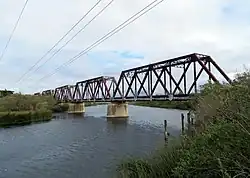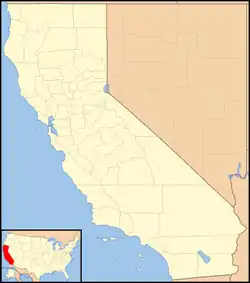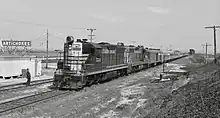Neponset, California
Neponset (Martin Station until 1900) is an unincorporated community in Monterey County, California.[1] It is located along the Southern Pacific Railroad and California State Route 1 between Marina, California and Castroville, California, and 8.5 miles (14 km) northwest of Salinas, California,[2] at an elevation of 23 feet (7 m).[1]
Neponset | |
|---|---|
 A railroad bridge over the Salinas River at Neponset | |
 Neponset Location in Monterey County and the state of California  Neponset Neponset (the United States) | |
| Coordinates: 36°43′43″N 121°47′5″W | |
| Country | United States |
| State | California |
| County | Monterey |
| Elevation | 187 ft (57 m) |
| • Summer (DST) | UTC-7 (PDT) |
| ZIP code | 93908 |
| Area code | 831 |
History
Neponset was once a Southern Pacific Railroad station south of the Salinas River along the Monterey Branch Line. The station was near Castroville, the self-proclaimed "Artichoke Capital of the World," It was on the boundary of Rancho Rincón de las Salinas at the corner of the marshland. Neponset is primarily undeveloped and used as agricultural land. A branch line can be seen at Neponset along the abandoned Monterey Branch line. Dole Fresh Vegetables of Dole Food Company occupies the site next to the station.[3]
In 1879, when the Southern Pacific Railroad purchased the Monterey & Salinas Valley Railroad, it built a new route between Castroville, California and Bardin. Two bridges crossover the Salinas River. The railroad put in place a station just south of the bridges called "Martin's Station". Passenger and freight service went through the station.[3]
Pioneer John Martin came to California with his family during the California Gold Rush. When they landed in Monterey by ship in 1856, they acquired a ranch at Neponset where the family became farmers. John's brother, Robert H. Martin, lived in Neponset. In 1879, John's father, William Martin, returned to Neponset and lived with John's sister, Mary, and John Jefferson, who had a large family. By 1880, the Jeffersons had eight children.[4] The Martin Ranch was sold on August 23, 1929, to millionaire tycoon Willis J. and Alma Walker of Pebble Beach. James, William, and Roy Martin of Carmel Valley, Robert Martin of Neponset, Carmel Martin of Monterey, and Isabel Martin of Carmel, were all born on the Martin Ranch.[5]
In 1890, Martin's Station had a school house and several ranches.
We had quite a light rain here yesterday afternoon. It commenced about 4 p.m. and lasted a couple of hours and I got partly wet coming from the river to the school house. However, it will keep the crops growing and help to keep the upper crust of the ground soft and be good for the country in general.
— Martin's Station, Salinas River, April 30, 1890, Pioneer '43[6]
Martin's station was renamed in 1900 to "Neponset", after Neponset, Boston, Massachusetts,[2] where the Neponset Indians were the original inhabitants.[7] Neponset was an Indigenous word meaning "little summer place".[3] In the early 1900s, several announcements of families living in Neponset were listed in The Californian newspaper. The Neponset Temperance Club was started by men of Neponset. William H. Martin was president and James A. Martin was treasurer. The club was formed for the promotion of sociability and the cause of temperance.[8]
The population of Neponset reached its peak in the 1920s when a water tower was built. In the 1930s, the town began to shrink, and passenger service stopped during World War II. The Neponset station was taken out from train schedules by 1960.[3]
Railroad information

Neponset was located one hundred and thirteen point nine miles (183 km) from San Francisco along Castroville, Gilroy, and San José, and fourteen point seven miles (24 km) from Lake Majella. The station had a 14 car track, a water tank that was installed in the 1920s, a class-A rail yard with a platform on the south side of the tracks that supported freight and passenger service. By 1951, the station no longer supported passenger service and its track shrank to only a 9 car track. On March 18, 1962, the Southern Pacific SD7 no. 5331, went westbound at Neponset, California, crossed the Salinas River to Monterey. By 1963, the station was taken out of Southern Pacific timetables.[3]
Monte Road is a frontage road that runs beside State Route 1, south of the Salinas River crossing. The railroad tracks still exist outside the Dole Food Company plant. The tracks break off just at the staff parking lot. Neponset Road wraps around the plant on its southern edge.[9]
See also
References
- U.S. Geological Survey Geographic Names Information System: Neponset, California
- Durham, David L. (1998). California's Geographic Names: A Gazetteer of Historic and Modern Names of the State. Clovis, Calif.: Word Dancer Press. p. 1045. ISBN 1-884995-14-4.
- "Martin & Neponset". Santa Cruz Trains Railroads of the Monterey Bay Area. May 15, 2015. Retrieved December 14, 2022.
- Neal Hotelling (December 10, 2021). "There were horses, cows and swine, but surprisingly, no sheep" (PDF). The Carmel Pine Cone. p. 23. Retrieved December 10, 2021.
- "Pebble Beach Couple Acquire Martin Ranch". The Carmel Pine Cone. June 18, 1926. p. 1. Retrieved December 15, 2022.
- "County Scraps. Martin's Station, Salinas River, April 30, 1890". The Californian. Salinas, California. May 2, 1890. Retrieved December 14, 2022.
- "John Eliot and Nonantum". William P. Marchione. March 22, 2017. Retrieved December 14, 2022.
- "Neponset Temperance Club". The Californian. Salinas, California. March 14, 1901. Retrieved December 14, 2022.
- Kyle, Douglas E.; Rensch, Hero Eugene; Rensch, Ethel Grace; Hoover, Mildred Brooke; Abeloe, William (1990). Historic Spots in California. Palo Alto, California: Stanford University Press. ISBN 9780804778176. Retrieved December 14, 2022.
